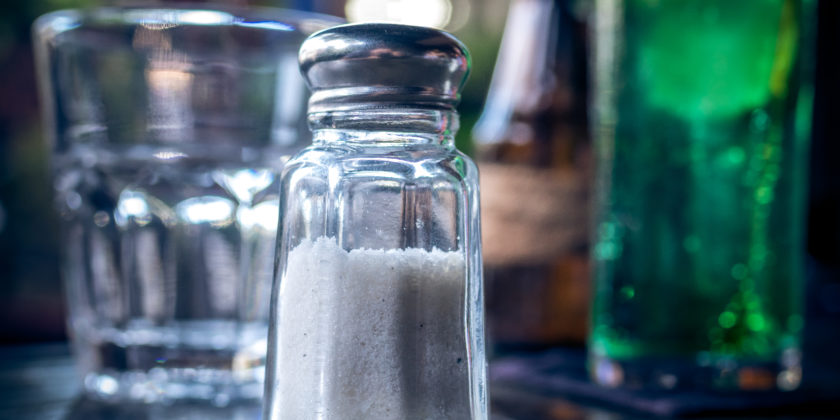Putting salt on watermelon during the summer months of Jay Harold’s youth was as natural adding sugar to hot white rice. Today, We know that too much salt could increase your risk for high blood pressure and too much sugar may lead to diabetes. “Sodium: Uses, Sources, Imbalances, Side Effects, & Tests,” is Jay Harold’s attempt to provide some useful info about sodium chloride (table salt).
Table salt1 is a combination of two minerals – sodium and chloride. Your body needs some sodium to work properly. It helps with the function of nerves and muscles. It also helps to keep the right balance of fluids in your body. Your kidneys control how much sodium is in your body. If you have too much and your kidneys can’t get rid it, sodium builds up in your blood. This can lead to high blood pressure. High blood pressure can lead to other health problems.
Most people in the U.S. get more sodium in their diets than they need. A key to healthy eating is choosing foods low in sodium. The Dietary Guidelines recommend that most adults eat less than 2.3 grams per day. That equals about one teaspoon of table salt a day. Some people are more sensitive to the effects of salt than others and should eat less. This includes people who have high blood pressure, diabetes, or kidney problems, or are African-American or over age 50. Reading food labels can help you see how much sodium is in prepared foods.
Sodium in diet2
Sodium is an element that the body needs to work properly. Salt contains sodium. You can get more detailed information on sodium by clicking on link #2 in the bibliography.
Sodium occurs naturally in most foods. The most common form of sodium is sodium chloride, which is table salt. Milk, beets, and celery also naturally contain sodium. Drinking water also contains sodium, but the amount depends on the source.
Sodium is also added to many food products. Some of these added forms are monosodium glutamate (MSG), sodium nitrite, sodium saccharin, baking soda (sodium bicarbonate), and sodium benzoate. These are in items such as Worcestershire sauce, soy sauce, onion salt, garlic salt, and bouillon cubes.
Processed meats like bacon, sausage, and ham, and canned soups and vegetables also contain added sodium. Fast foods are generally very high in sodium.
Side Effects
Too much sodium in the diet may lead to:
- High blood pressure in some people
- A serious build-up of fluid in people with heart failure, cirrhosis of the liver, or kidney disease
Recommendations
Sodium in the diet (called dietary sodium) is measured in milligrams (mg). Table salt is 40% sodium. One teaspoon (5 milliliters) of table salt contains 2,300 mg of sodium.
Healthy adults should limit sodium intake to 2,300 mg per day. Adults with high blood pressure should have no more than 1,500 mg per day. Those with congestive heart failure, liver cirrhosis, and kidney disease may need much lower amounts.
There are no specific recommended amounts of sodium for infants, children, and teens. Eating habits and attitudes about food that are formed during childhood are likely to influence eating habits for life. For this reason, it is a good idea for children to avoid eating too much salt3.
Sodium Blood Test4
The sodium blood test measures the amount of sodium in the blood. Sodium can also be measured using a urine test5.
How the Test is Performed
A blood sample is needed.

How to Prepare for the Test
Your health care provider may tell you to temporarily stop taking medicines that may affect the test. These include:
- Antibiotics
- Antidepressants
- Some high blood pressure medicines
- Lithium
- Nonsteroidal anti-inflammatory drugs (NSAIDs)
- Water pills (diuretics)
DO NOT stop taking any medicine before talking to your provider.
How the Test will Feel
When the needle is inserted to draw blood, some people feel moderate pain. Others feel only a prick or stinging. Afterward, there may be some throbbing or slight bruising. This soon goes away.
Why the Test is Performed
Sodium is a substance that the body needs to work properly. Sodium is found in most foods. The most common form of sodium is sodium chloride, which is table salt.
This test is usually done as part of an electrolyte or basic metabolic panel blood test6.
Your blood sodium level represents a balance between the sodium and water in the food and drinks you consume and the amount in your urine. A small amount is lost through stool and sweat.
Many things can affect this balance. Your provider may order this test if you:
- Have had a recent injury, surgery, or serious illness
- Consume large or small amounts of salt or fluid
- Receive intravenous (IV) fluids
- Take diuretics (water pills) or certain other medicines, including the hormone aldosterone
Normal Results

The normal range for blood sodium levels is 135 to 145 mEq/L.
Normal value ranges may vary slightly among different laboratories. Some labs use different measurements or test different samples. Talk to your provider about the meaning of your specific test results.
What Abnormal Results Mean
An abnormal sodium level can be due to many different conditions.
Higher than normal sodium level is called hypernatremia. It may be due to:
- Increased fluid loss due to excessive sweating, diarrhea, burns, or use of diuretics
- Adrenal gland problems such as Cushing syndrome7 or hyperaldosteronism8
- Diabetes insipidus (type of diabetes in which kidneys are not able to conserve water)
- Too much salt or sodium bicarbonate in the diet
- Use of certain medicines, including corticosteroids, laxatives, lithium, and medicines such as ibuprofen or naproxen
Lower than normal sodium level is called hyponatremia. It may be due to:
- Use of medicines such as diuretics (water pills), morphine, and selective serotonin reuptake inhibitor (SSRI) antidepressants
- Increased fluid loss from body, vomiting, or diarrhea
- Increase in total body water seen in those with heart failure, certain kidney diseases, or cirrhosis of the liver
- Adrenal glands not making enough of their hormones (Addison disease)
- Buildup in urine of waste product from fat breakdown (ketonuria)
- Syndrome of inappropriate antidiuretic hormone secretion9 (antidiuretic hormone is released from an abnormal place in the body)
- Too much of the hormone vasopressin
Risks
There is very little risk involved with having your blood taken. Veins and arteries vary in size from one person to another and from one side of the body
 to the other. Taking blood from some people may be more difficult than from others.
to the other. Taking blood from some people may be more difficult than from others.
Other risks associated with having blood drawn are slight but may include:
- Excessive bleeding
- Fainting or feeling lightheaded
- Hematoma (blood accumulating under the skin)
- Infection (a slight risk any time the skin is broken)
Jay Harold hopes you enjoyed, “Sodium: Uses, Sources, Imbalances, Side Effects, & Tests.” Please Share it and read more here. Jay Harold has put together a Resource page that you may find useful when trying to improve your health and wealth. Please take this advice from Muhammad Ali and give back to others. “Service to others is the rent you pay for your room here on earth.”
Bibliography
- https://vsearch.nlm.nih.gov/vivisimo/cgi-bin/query-meta?v%3Aproject=medlineplus&v%3Asources=medlineplus-bundle&query=sodium
- https://medlineplus.gov/ency/article/002415.htm
- https://medlineplus.gov/ency/patientinstructions/000109.htm
- https://medlineplus.gov/ency/article/003481.htm
- https://medlineplus.gov/ency/article/003599.htm
- https://medlineplus.gov/ency/article/003462.htm
- https://medlineplus.gov/ency/article/000410.htm
- https://medlineplus.gov/ency/article/000330.htm
- https://medlineplus.gov/ency/article/000314.htm




